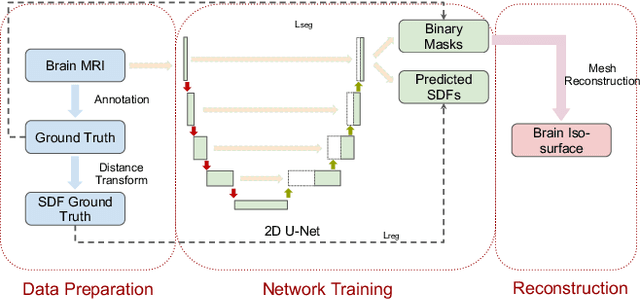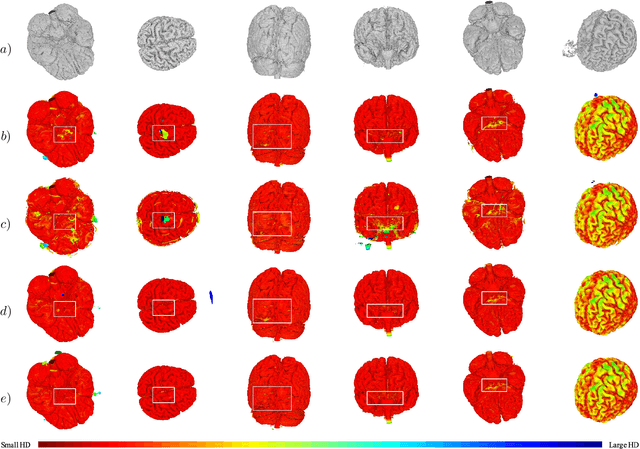Taichi Kin
Brain Surface Reconstruction from MRI Images Based on Segmentation Networks Applying Signed Distance Maps
Apr 09, 2021


Abstract:Whole-brain surface extraction is an essential topic in medical imaging systems as it provides neurosurgeons with a broader view of surgical planning and abnormality detection. To solve the problem confronted in current deep learning skull stripping methods lacking prior shape information, we propose a new network architecture that incorporates knowledge of signed distance fields and introduce an additional Laplacian loss to ensure that the prediction results retain shape information. We validated our newly proposed method by conducting experiments on our brain magnetic resonance imaging dataset (111 patients). The evaluation results demonstrate that our approach achieves comparable dice scores and also reduces the Hausdorff distance and average symmetric surface distance, thus producing more stable and smooth brain isosurfaces.
Surface-based 3D Deep Learning Framework for Segmentation of Intracranial Aneurysms from TOF-MRA Images
Jun 29, 2020



Abstract:Segmentation of intracranial aneurysms is an important task in medical diagnosis and surgical planning. Volume-based deep learning frameworks have been proposed for this task; however, they are not effective. In this study, we propose a surface-based deep learning framework that achieves higher performance by leveraging human intervention. First, the user semi-automatically generates a surface representation of the principal brain arteries model from time-of-flight magnetic resonance angiography images. The system then samples 3D vessel surface fragments from the entire brain artery model and classifies the surface fragments into those with and without aneurysms using the point-based deep learning network (PointNet++). Next, the system applies surface segmentation (SO-Net) to the surface fragments containing aneurysms. We conduct a head-to-head comparison of segmentation performance by counting voxels between the proposed surface-based framework and existing pixel-based framework, and our framework achieved a much higher dice similarity coefficient score (72%) than the existing one (46%).
IntrA: 3D Intracranial Aneurysm Dataset for Deep Learning
Apr 06, 2020



Abstract:Medicine is an important application area for deep learning models. Research in this field is a combination of medical expertise and data science knowledge. In this paper, instead of 2D medical images, we introduce an open-access 3D intracranial aneurysm dataset, IntrA, that makes the application of points-based and mesh-based classification and segmentation models available. Our dataset can be used to diagnose intracranial aneurysms and to extract the neck for a clipping operation in medicine and other areas of deep learning, such as normal estimation and surface reconstruction. We provide a large-scale benchmark of classification and part segmentation by testing state-of-the-art networks. We also discuss the performance of each method and demonstrate the challenges of our dataset. The published dataset can be accessed here: https://github.com/intra3d2019/IntrA.
 Add to Chrome
Add to Chrome Add to Firefox
Add to Firefox Add to Edge
Add to Edge